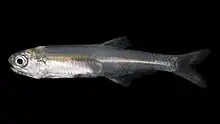Anchoa mitchilli
Anchoa mitchilli is a species of ray-finned fish in the family Engraulidae, the anchovies. Its common names include bay anchovy and common anchovy.[1] It is native to the western Atlantic Ocean and Gulf of Mexico.[1] It is one of the most common fish species along the coastlines of the western Atlantic.[2]
| Anchoa mitchilli | |
|---|---|
 | |
| Scientific classification | |
| Domain: | Eukaryota |
| Kingdom: | Animalia |
| Phylum: | Chordata |
| Class: | Actinopterygii |
| Order: | Clupeiformes |
| Family: | Engraulidae |
| Genus: | Anchoa |
| Species: | A. mitchilli |
| Binomial name | |
| Anchoa mitchilli (Valenciennes, 1848) | |
| Synonyms | |
| |
Etymology
The fish is named in honor of Samuel Latham Mitchill (1764–1831), naturalist, physician and U.S. Senator, who studied the fishes of New York.[3]
Description
The bay anchovy is somewhat variable in appearance.[4] It is a small, slender, schooling fish with a greenish body and a silvery stripe. It is characterized by its very long jaw, silvery belly, lateral stripe, and single dorsal fin. The dorsal fin is located directly above the anal fin origin.[5] The adult male is generally about 6 centimeters long, with a maximum length of 10[4] to 11 centimeters.[1] It has 14 to 16 rays in its dorsal fin, 24 to 30 in its anal fin, and 11 to 12 in the pectoral.[6] It may live more than three years.[1]
The bay anchovy is similar to other species in the genus Anchoa which occur in the same regions. The broad-striped anchovy is similar in appearance but grows to a larger size, up to 15 centimeters. The Cuban anchovy has its anal fin set farther back on the body.[6]
Range and habitat
This species is distributed in the Atlantic Ocean and Gulf of Mexico along the eastern coasts of North America from Maine to Yucatán.[6] It does not occur in the West Indies.[4] It is well known in the Chesapeake Bay, where it is the most abundant fish.[7]
It occurs in a wide range of water temperatures and salinities, including some hypersaline environments.[6] It does not tolerate low-oxygen waters and easily asphyxiates when deprived of oxygen.[6]
This fish spends most of its time cruising the water column. It can also be found over bare substrates at the ocean floor and in tide pools and surf zones.[6] It can live in muddy, brackish waters.[4] It rarely enters waters deeper than 25 meters.[1]
Biology and ecology
This fish feeds on zooplankton, including copepods, mysids, and crab larvae.[6]
It is in turn an important prey item for a variety of larger fish, including weakfish (Cynoscion regalis), striped bass (Morone saxatilis), chain pickerel (Esox niger), and bluefish (Pomatomus saltatrix).[6] Birds such as royal terns (Thalasseus maximus) and Sandwich terns (T. sandvicensis) feed on it.[6]
This species is an important link in the food web in many ecosystems. It is a major pathway by which zooplankton biomass is converted to the biomass of larger fish.[1]
The bay anchovy is sexually mature when it reaches about 4 centimeters in length. It spawns in the water column in shallow and deeper waters. In the southern part of its range it spawns year-round, and farther north it breeds during the warmer months.[6] A female can spawn 50 times in one season, producing over 1000 eggs each time. Eggs hatch in 24 hours.[7] Larvae mature in about 45 days. Their growth rates are variable and may depend on the availability of food.[6]
Human uses
This species is made into anchovy paste and is used as a bait fish.[1] It is harvested as a rough fish and used for fish oil and fish paste.[6]
Conservation
This fish is not of conservation concern. It has an extensive range, a large and stable population made up of many subpopulations, and no major threats.[1]
References
- NatureServe. 2013. Anchoa mitchilli. The IUCN Red List of Threatened Species 2013. Downloaded on 13 June 2016.
- Newberger, T. A. and E. D. Houde. 1995. Population biology of bay anchovy Anchoa mitchilli in the mid Chesapeake Bay. Marine Ecology Progress Series 116 25-37.
- The Etyfish Project
- Froese, R. and D. Pauly, Eds. Anchoa mitchilli. FishBase. 2016.
- DeLancey, L. Anchoa mitchilli. Comprehensive Wildlife Conservation Strategy, South Carolina Department of Natural Resources. 2006.
- Masterson, J. Anchoa mitchilli. Smithsonian Marine Station, Fort Pierce. 2008.
- Anchoa mitchilli. Field Guide. Chesapeake Bay Program.
Further reading
- Jung, S. and E. D. Houde. 2004. Recruitment and spawning-stock biomass distribution of bay anchovy (Anchoa mitchilli) in Chesapeake Bay. Fishery Bulletin 102(1) 63-77.
- North, E. W. and E. D. Houde. 2004. Distribution and transport of bay anchovy (Anchoa mitchilli) eggs and larvae in Chesapeake Bay. Estuarine, Coastal and Shelf Science 60(3), 409-29.
- Peebles, E. B., J. R. Hall, and S. B. Tolley. 1996. Egg production by the bay anchovy Anchoa mitchilli in relation to adult and larval prey fields. Marine Ecology Progress Series 134 61-73.
- Scharf, F. S., J. A. Buckel, and F. Juanes. 2002. Size-dependent vulnerability of juvenile bay anchovy Anchoa mitchilli to bluefish predation: Does large body size always provide a refuge? Marine Ecology Progress Series 233 241-52.
- Schultz, E. T., et al. 2000. Explaining advection: do larval bay anchovy (Anchoa mitchilli) show selective tidal-stream transport? ICES Journal of Marine Science: Journal du Conseil 57(2), 360-71.
